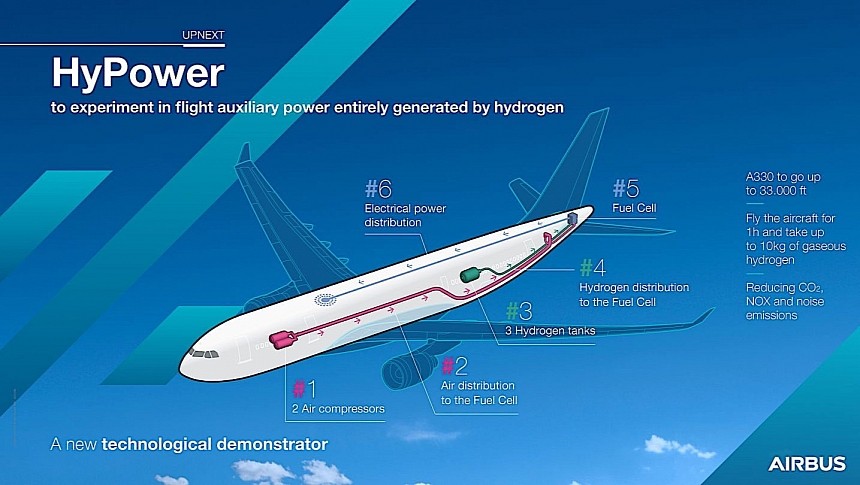Just as the Paris Air Show is taking place in the skies over the French capital, aerospace giant Airbus announced two major developments in its quest to make aviation greener. The first is the completion of the HyPERION project. The second, something called HyPower.
Whereas HyPERION was an idea meant to find the best technologies needed to make hydrogen a suitable fuel for commercial aviation, HyPower targets the same hydrogen, only this time as a source of power for non-propulsive tech.
You see, an airplane needs energy to keep the engines running and itself flying, but it also needs power for internal systems, stuff like air conditioning, onboard lighting, and avionics.
Traditionally, power for these systems comes through something called the Auxiliary Power Unit (APU). That's in essence an engine that runs on regular aviation fuel, but only feeds these additional systems, backed by the aircraft's engines themselves.
Airbus through its technology division UpNext plans to replace the traditional APU with a hydrogen fuel cell system and see how much fuel economy can be achieved this way.
The tech is to enter testing stage on an A330, and it will be put through its paces both on the ground on a test bed and in flight on the plane itself. The first time this modified aircraft is expected to take to the sky is the end of 2025.
The main goals of the tests are according to UpNext CEO Michael Augello to show the "operability and integration of the system, including refueling the aircraft with hydrogen."
Even if the first flight test is a few years away, we already know the procedure will have the A330 climb to 25,000 feet (7,600 meters) and fly for an hour. The plane will be loaded with 10 kg (22 pounds) of hydrogen in gaseous form to be used for putting the HyPower through its paces.
The key things Airbus is looking to learn is how to operate the fuel cell in a stable manner during flight, including how to restart it.
If successful and applied on a large scale, the HyPower and similar systems will of course help cut down on the CO2 and other harmful emissions airplanes are responsible for. Noise levels from flying aircraft should also drop as a result of using a fuel cell instead of a conventional APU.
At the time of writing, the aviation industry is one of the world's biggest polluters. In 2021 alone, while the pandemic was still raging, it was responsible for releasing 36.3 billion tonnes of CO2 into the atmosphere.
That's just about two percent of the yearly global CO2 emissions, but a huge quantity by any standards, any drop in these levels can only be welcomed.
You see, an airplane needs energy to keep the engines running and itself flying, but it also needs power for internal systems, stuff like air conditioning, onboard lighting, and avionics.
Traditionally, power for these systems comes through something called the Auxiliary Power Unit (APU). That's in essence an engine that runs on regular aviation fuel, but only feeds these additional systems, backed by the aircraft's engines themselves.
Airbus through its technology division UpNext plans to replace the traditional APU with a hydrogen fuel cell system and see how much fuel economy can be achieved this way.
The tech is to enter testing stage on an A330, and it will be put through its paces both on the ground on a test bed and in flight on the plane itself. The first time this modified aircraft is expected to take to the sky is the end of 2025.
The main goals of the tests are according to UpNext CEO Michael Augello to show the "operability and integration of the system, including refueling the aircraft with hydrogen."
Even if the first flight test is a few years away, we already know the procedure will have the A330 climb to 25,000 feet (7,600 meters) and fly for an hour. The plane will be loaded with 10 kg (22 pounds) of hydrogen in gaseous form to be used for putting the HyPower through its paces.
The key things Airbus is looking to learn is how to operate the fuel cell in a stable manner during flight, including how to restart it.
If successful and applied on a large scale, the HyPower and similar systems will of course help cut down on the CO2 and other harmful emissions airplanes are responsible for. Noise levels from flying aircraft should also drop as a result of using a fuel cell instead of a conventional APU.
At the time of writing, the aviation industry is one of the world's biggest polluters. In 2021 alone, while the pandemic was still raging, it was responsible for releasing 36.3 billion tonnes of CO2 into the atmosphere.
That's just about two percent of the yearly global CO2 emissions, but a huge quantity by any standards, any drop in these levels can only be welcomed.









